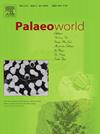The late Eocene pine seed cones from Mangkang Basin, southeastern Xizang (Tibet) and their biogeographic significance
IF 1.7
3区 地球科学
Q2 PALEONTOLOGY
引用次数: 0
Abstract
Pinus is widely distributed in the Northern Hemisphere, and today is the largest gymnosperm genus with a rich fossil record. However, the biogeographic history at section or subsection level remains unclear. Here, we report a new finding of female cones from the late Eocene of the Mangkang Basin, southeastern Xizang (Tibet). By morphological comparison between fossil and extant species, this cone type is identified as a new species in subsection Pinus, namely Pinus mangkangensis Yao and Su, n. sp. This new species is morphologically similar to the living species P. yunnanensis, which is distributed in Southwest China adjacent to the fossil site. The finding of P. mangkangensis provides important evidence for elucidating the biogeographic history and diversification of subsection Pinus in Southwest China. Together with other fossil records of section Pinus in East Asia, we propose that P. mangkangensis represents southern lineages and suggests that ancestral species of subsection Pinus dispersed to lower latitude regions during the Eocene. Subsequently, the diversification of species in subsection Pinus took place during the Miocene.
西藏东南部芒康盆地晚始新世松子球果及其生物地理意义
松树广泛分布于北半球,是目前最大的裸子植物属,化石记录丰富。然而,在区域或分区水平上的生物地理历史尚不清楚。本文报道了西藏东南部芒康盆地晚始新世雌锥虫的新发现。通过化石和现存种的形态比较,该球型为Pinus分节中的一个新种,即Pinus mangkangensis Yao和Su, n. sp.,该新种与分布在化石遗址附近的中国西南地区的现存种P. yunnanensis形态相似。这一发现为阐明西南分节松的生物地理历史和多样性提供了重要依据。结合东亚地区其他松科的化石记录,我们认为曼康松属属于南方谱系,并认为松科的祖先物种在始新世时向低纬度地区分散。随后,在中新世,松林分节的物种发生了多样化。
本文章由计算机程序翻译,如有差异,请以英文原文为准。
求助全文
约1分钟内获得全文
求助全文
来源期刊

Palaeoworld
PALEONTOLOGY-
CiteScore
4.00
自引率
5.90%
发文量
95
期刊介绍:
Palaeoworld is a peer-reviewed quarterly journal dedicated to the study of past life and its environment. We encourage submission of original manuscripts on all aspects of palaeontology and stratigraphy, comparisons of regional and global data in time and space, and results generated by interdisciplinary investigations in related fields. Some issues will be devoted entirely to a special theme whereas others will be composed of contributed articles. Palaeoworld is dedicated to serving a broad spectrum of geoscientists and palaeobiologists as well as serving as a resource for students in fields as diverse as palaeobiology, evolutionary biology, taxonomy and phylogeny, geobiology, historical geology, and palaeoenvironment.
Palaeoworld publishes original articles in the following areas:
•Phylogeny and taxonomic studies of all fossil groups
•Biostratigraphy, chemostratigraphy, chronostratigraphy
•Palaeoecology, palaeoenvironment and global changes throughout Earth history
•Tempo and mode of biological evolution
•Biological events in Earth history (e.g., extinctions, radiations)
•Ecosystem evolution
•Geobiology and molecular palaeobiology
•Palaeontological and stratigraphic methods
•Interdisciplinary studies focusing on fossils and strata
 求助内容:
求助内容: 应助结果提醒方式:
应助结果提醒方式:


